Extended Query
Parameter
As you have seen in the introduction the basic filter in the extended
query are the selected Project and Additional projects. You may
introduce additional query restrictions for description data,
description scopes and descriptor conditions, which are shown in the
Query parameter area. By clicking on button
 Add description,
Add description,
 Add scope or
Add scope or
 Add descriptor in the Query
parameter tool strip a query parameter control is inserted at the end
of the query parameter list. When you enter query parameter, the field
Matches: will be updated immediatly. To see the Result list, you
will have to click on button
Add descriptor in the Query
parameter tool strip a query parameter control is inserted at the end
of the query parameter list. When you enter query parameter, the field
Matches: will be updated immediatly. To see the Result list, you
will have to click on button  Show matches (see
picture below).
Show matches (see
picture below).
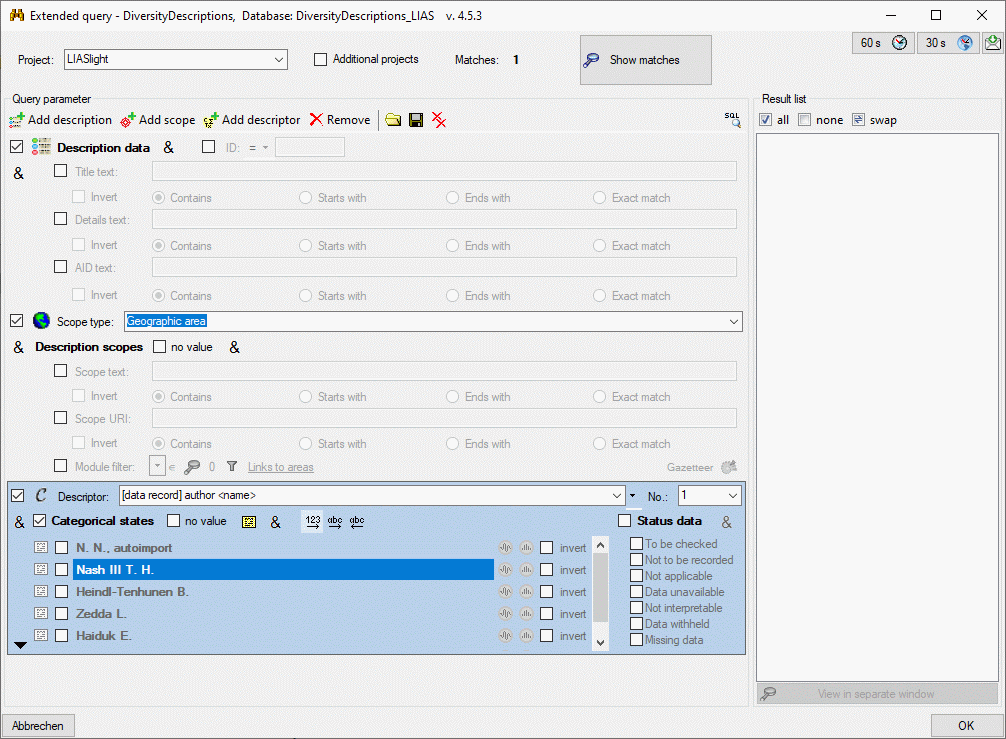
If you have entered several parameter controls, you might wish to
de-activate one of them temporarily, e.g. to check its effect on the
result list. Remove the check mark in the beginning of the first line of
the query parameter (see item 1 in image below) and the whole condition
will be ignored. Below this check box you find by default the symbol
(see item 2 in image below), which means “logical
AND”. If you specify several query parameter controls, which are all
adjusted to , a matching description must fulfill all
entered query conditions simultaneously.
You may click on the symbol to change it to
(see item 3 in image
below), which means “logical OR”. In this case the result list will
include all descriptions that fulfill the first descriptor condition and
additionally all descriptions, which fulfill the second condition. I.e.
each “AND” condition will reduce the list of matching descriptions and
each “OR” condition will add its matching descriptions to the result
list.

By clicking on a parameter control it is selected as the active control
(see above). The active parameter control is shown with light blue background. The resulting SQL query
may be viewed with button  . You can delete the
current query control by clicking on button
. You can delete the
current query control by clicking on button  Remove or all query controls by clicking on button
Remove or all query controls by clicking on button
 in the Query parameter tool strip.
in the Query parameter tool strip.
Continue with:
Subsections of Parameter
Extended Query
Description conditions
Press button  Add description in the
Query parameter tool strip to insert a new query parameter condition
to search for specific values in the description data. A control
representing a single description data filter will be added at the end
of the query parameter list. You may enter filter criteria for the
description ID, Title text, Details text and AID text
(alternate id). To enable a certain item, select the check box before
the parameter text (picture below). For the numeric parameter ID you
may enter a number and select the comparer by clicking the button
. Available comparers are
= (equal), ≠ (not equal), < (less), >
(greater), ≤ (less or equal) and ≥ (greater or equal).
Add description in the
Query parameter tool strip to insert a new query parameter condition
to search for specific values in the description data. A control
representing a single description data filter will be added at the end
of the query parameter list. You may enter filter criteria for the
description ID, Title text, Details text and AID text
(alternate id). To enable a certain item, select the check box before
the parameter text (picture below). For the numeric parameter ID you
may enter a number and select the comparer by clicking the button
. Available comparers are
= (equal), ≠ (not equal), < (less), >
(greater), ≤ (less or equal) and ≥ (greater or equal).
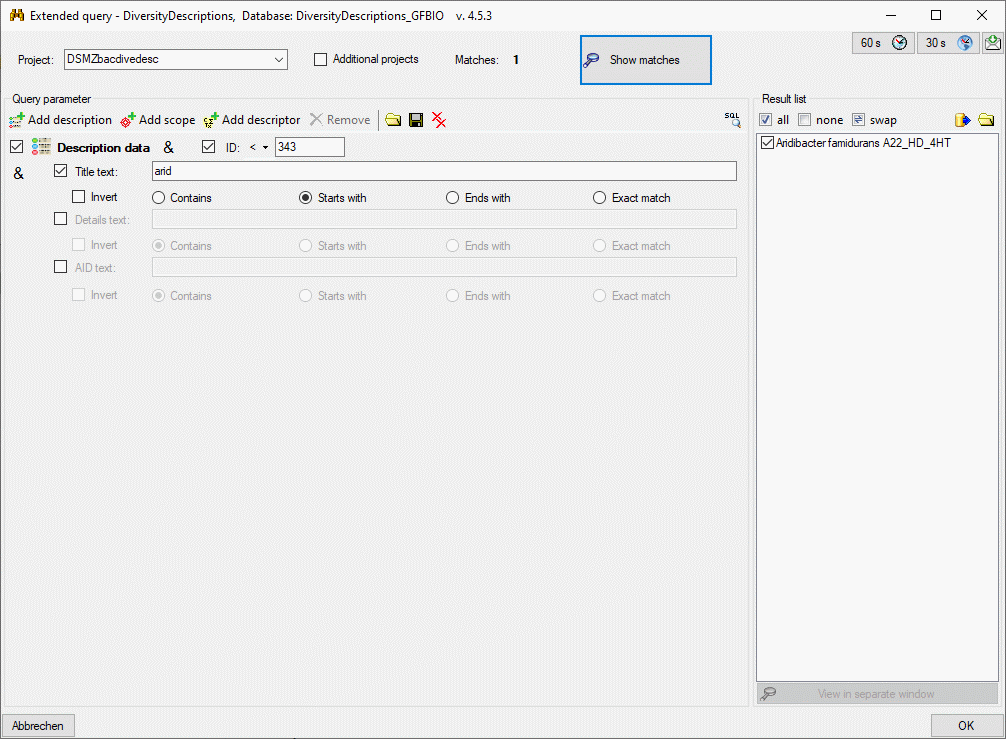
For the text parameters (title, details and AID) you may enter a search
text and select one the matching options Contains, Starts with,
Ends with or Exact match. Capitalization is not taken into
account. For option Contains the database text must contain the
search text. The options Starts with and Ends with only check
the database text begin rsp. end for a match. Finally option Exact
match requires identical texts. For option Exact match you may
enter an empty text, which will match if in the database an empty text
or a NULL value (if a NULL value is allowed) is present. For the other
matching options an empty search text does not make sense because it
will allways match. By checking the Invert option you may invert the
search criteria. E.g. the option Exact match with empty search text
and Invert will search for “text present” (“not empty string”). You
may use the wildcards _,
[] and [^]
in your search text, but not %. % is automatically inserted in the correct places
by selecting the matching option.
If you entered more than one condition as shown in the image above
(ID and Title text), the default adjustment is that all
conditions must match. This is indicated by the symbol
behind the text  Description
data in the header line, which means “logical AND”. If you want to get
a match for any of the entered conditions, you may click on the symbol
to change it to
“logical OR” (see
image below).
Description
data in the header line, which means “logical AND”. If you want to get
a match for any of the entered conditions, you may click on the symbol
to change it to
“logical OR” (see
image below).
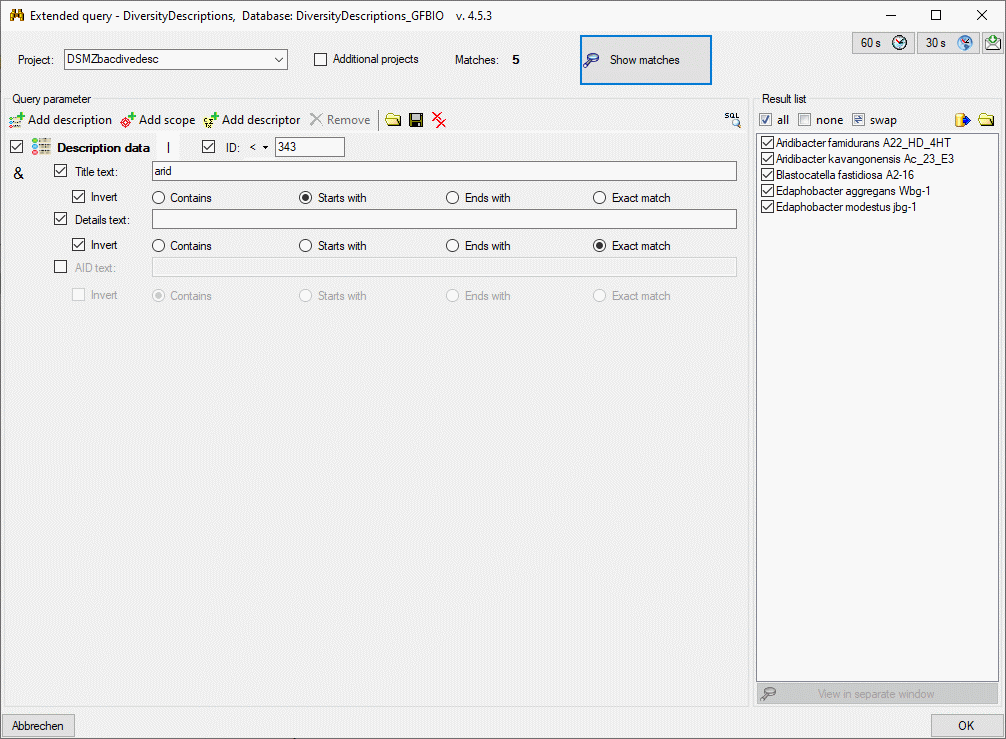
The next example shows how two description conditions are used to
exclude a certain number range of the ID from the result list. The
first condition restricts the result list to all IDs smaller than 343.
The second condition adds all results with IDs larger than 426, which is
achieved by a logical OR of the condition operator
(). In this example
it does not matter which one of the two conditions is marked as “AND”
rsp. “OR”. If both conditions would be marked as “OR”, there would not
be any restriction left except the project.
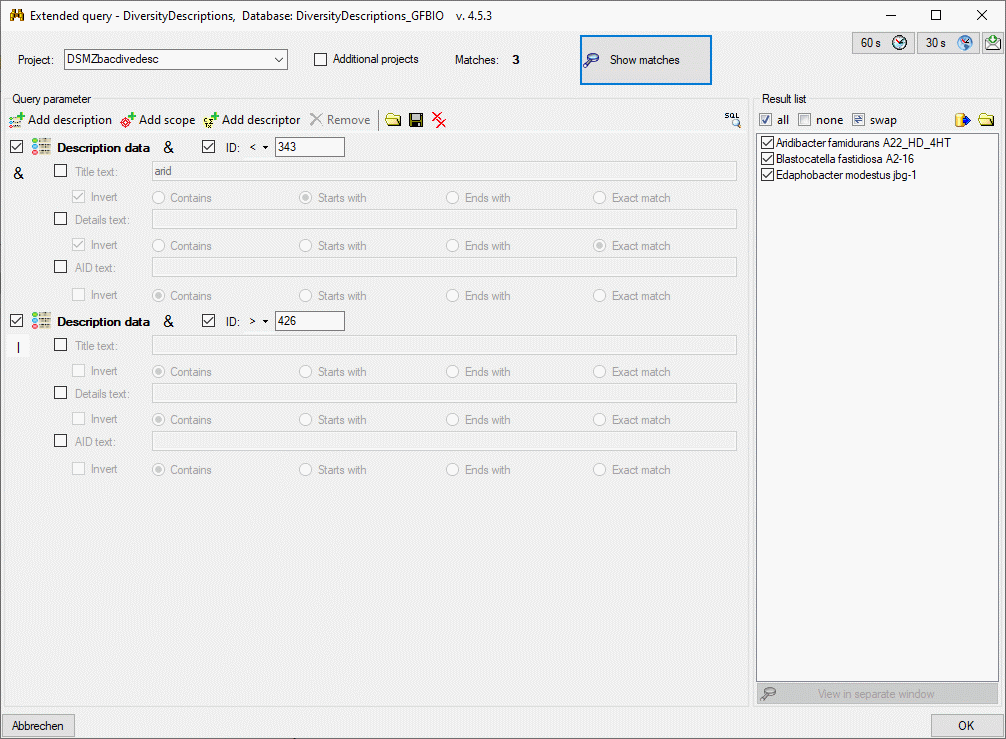
Continue with:
Extended Query
Descriptor conditions
Press button  Add descriptor in the
Query parameter tool strip to insert a new query condition for the
search of specific values in the description summary data. A control
representing a single descriptor filter will be added at the end of the
query parameter list. Now you have to select the descriptor that shall
be included in the search filter. This can be done by selecting the
descriptor’s sequence number with combo box No.:, from an
alphabetical descriptor list with combo box Descriptor: or by
selecting from the descriptor tree with button
(see picture below).
Add descriptor in the
Query parameter tool strip to insert a new query condition for the
search of specific values in the description summary data. A control
representing a single descriptor filter will be added at the end of the
query parameter list. Now you have to select the descriptor that shall
be included in the search filter. This can be done by selecting the
descriptor’s sequence number with combo box No.:, from an
alphabetical descriptor list with combo box Descriptor: or by
selecting from the descriptor tree with button
(see picture below).

After selecting the descriptor the query control shows query parameters
depending on the descriptor type (see below). You may search for
descriptions that do not have any data for the selected descriptor by
checking option absent. The currently marked parameter control is
shown with light blue background. You can
delete the current query control by clicking on button
 Remove or all query controls by clicking on
button
Remove or all query controls by clicking on
button  in the Query parameter tool strip.
in the Query parameter tool strip.
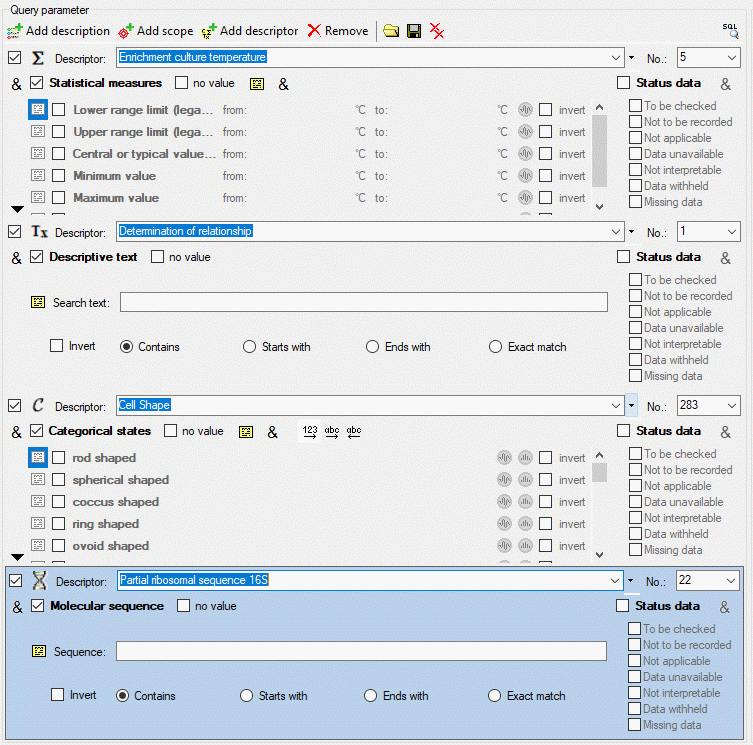
In the parameter control the descriptor type is indicated by symbols in
the beginning of the first line ( categorical,
categorical,
 quantitive,
quantitive,  text or
text or
 sequence). If additional information for the
descriptor are available in the database, you can show them as bubble
help by moving the mouse cursor over the symbol. If resource data are
available for a descriptor, the symbol is displayed with coloured
background and you can view them by double-clicking it (see image
below).
sequence). If additional information for the
descriptor are available in the database, you can show them as bubble
help by moving the mouse cursor over the symbol. If resource data are
available for a descriptor, the symbol is displayed with coloured
background and you can view them by double-clicking it (see image
below).
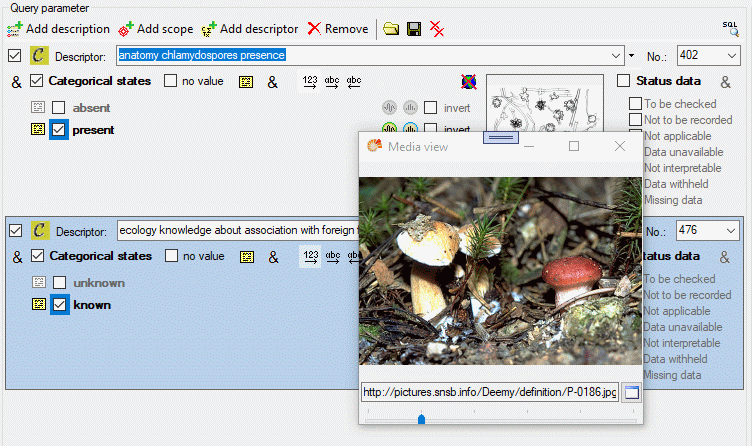
Each parameter control has two main sections:
- At the left you find the section for the descriptor parameter,
depending on its type (Categorical
states, Statistical
measures, Descriptive
text or Molecular
sequence). If this section is checked
and no other data have been entered, the query filters for all
descriptions that include any value for that descriptor, e.g. any
descriptive text or any categorical state. You may search for
descriptions without descriptor data by checking option no value.
By entering additional query data, the filter becomes more
restrictive.
- At the right you find the section for the descriptor Status data.
If this section is checked and no status value has been selected, the
query filters for all descriptions that include any status data value
for that descriptor. At the end of the Status data check box by
default the symbol indicates that all selected
data status values must be present in the matching descriptions. By
checking dedicated status data values, the filter becomes more
restrictive (logical AND). If you click on the
symbol you can change it to
 (logical OR) to
find matches for any of the selected status data values.
(logical OR) to
find matches for any of the selected status data values.
If both sections are selected, matching descriptors must fulfill both
conditions, i.e. the value must be present and the status data value
must be set.
Notes
In the descriptive data you may enter free text notes to all text and
sequence data. Furthermore individual notes may be entered for every
selected categorical state and statistical measure. You may include
additional query contitions for each of those notes, therefore the
symbol  is included at the appropriate places. To
enter a query condition, click the button and a window as shown below
will be opened.
is included at the appropriate places. To
enter a query condition, click the button and a window as shown below
will be opened.
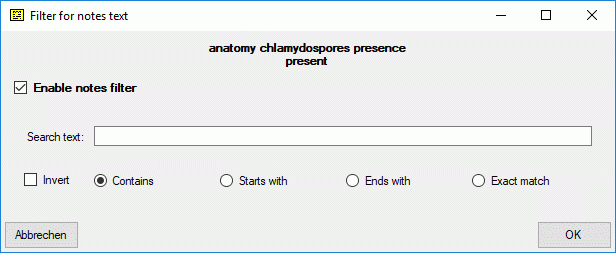
You may enter a Search text that shall be part of the notes text.
Capitalization is not taken into account. For option Contains the
notes text must contain the search text. The options Starts with and
Ends with only check the descriptor text begin rsp. end for a match.
Finally option Exact match requires identical texts. Check the
option Invert to invert the search criteria. You may use the
wildcards _, [] and [^] in
your search text, but not %. % is automatically inserted in the correct places
by selecting the matching option.When you click OK the additional
query condition will be active and the icon background changes to red ( ). If you want to
remove the query condition, open the notes form, uncheck the Enable
notes filter option and click OK.
). If you want to
remove the query condition, open the notes form, uncheck the Enable
notes filter option and click OK.
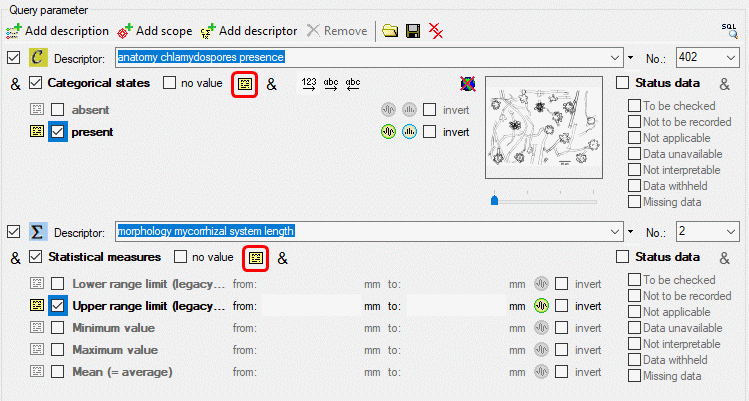
For text and molecular sequence data exactly one note is
possible for each descriptor value, therefore you find exactly one
symbol  for entering a query condition. For
categorical and quantitative data you may enter a note for each
single state rsp. statistical measure. Here you may search for notes of
the specific state rsp. measure by clicking on the
for entering a query condition. For
categorical and quantitative data you may enter a note for each
single state rsp. statistical measure. Here you may search for notes of
the specific state rsp. measure by clicking on the  symbol located at the element. Additionally you may search for notes
entered at any state or measure of the descriptor. Therefore an
additional symbol
symbol located at the element. Additionally you may search for notes
entered at any state or measure of the descriptor. Therefore an
additional symbol  is located in the header section
besides the no value check box (see image above).
is located in the header section
besides the no value check box (see image above).
Modifier and frequency
In categorical and quantitative descriptive data you may select modifier
values for every selected categorical state and statistical measure. For
categorical data additionally a frequency value may be selected. You may
include additional query contitions for each of those modifier and
frequency values, therefore the symbols  (modifier) and
(modifier) and  (frequency) are included at the
appropriate places. To enter a query condition, click the button and a
window as shown below will be opened.
(frequency) are included at the
appropriate places. To enter a query condition, click the button and a
window as shown below will be opened.
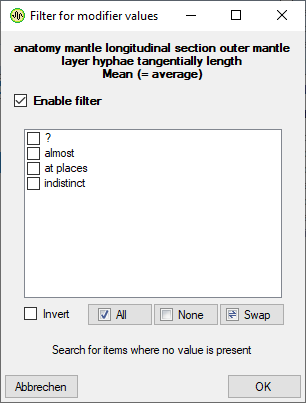
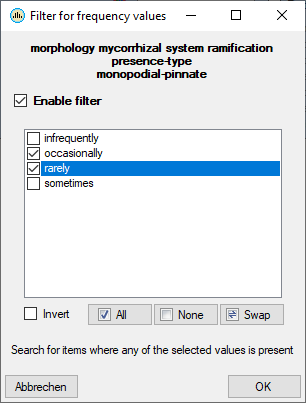
You may select the modifier rsp. frequency values for filtering from the
recommended values of the
current descriptor. Check the option Invert to invert the search
criteria. A hint text explaining the resulting filter will be displayed
in the lower area of the window. When you click OK the additional
query condition will be active and the icon background changes to red ( ,
,
 ). If you want to remove the query
condition, open the form, uncheck the Enable filter option and click
OK.
). If you want to remove the query
condition, open the form, uncheck the Enable filter option and click
OK.
Continue with:
Subsections of Descriptor conditions
Extended Query
Categorical states
In this query control the categorical states are listed. If pictures or
colours are assigned to the categorical states, they can be viewed by
clicking on the state name (see picture below). You may switch off
automatic loading of the resource view by clicking the button
 (“no web”), which will be indicated by a yellow symbol background. If this “no web” option
is activated, only local resources, e.g. colours, will be shown. If
during loading of remote resources an error occurs, e.g. due to a
timeout, the “no web” option will automatically be activated.
(“no web”), which will be indicated by a yellow symbol background. If this “no web” option
is activated, only local resources, e.g. colours, will be shown. If
during loading of remote resources an error occurs, e.g. due to a
timeout, the “no web” option will automatically be activated.
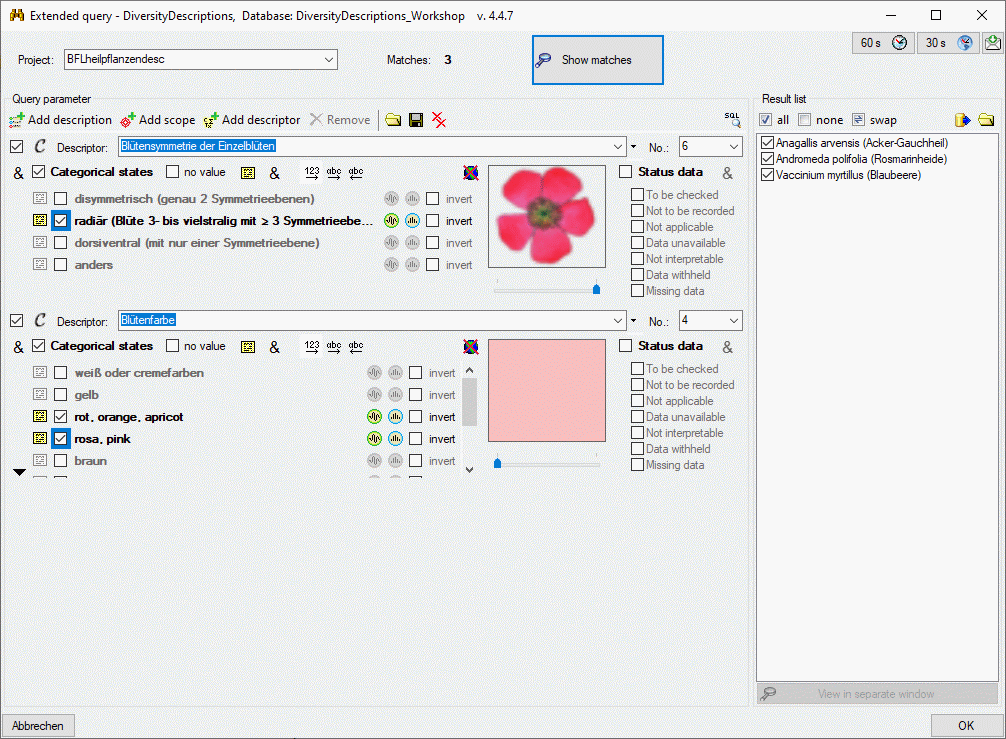
You may change the display order of the states between the standard
numeric order <img src=“img/IcoOrder.gif?class=inlineimg),
alphabetical order  and reverse alphabetical
order
and reverse alphabetical
order  by clicking the appropriate button. If
the state list exceeds the standard height of the control, a scroll bar
will show at the right side of the state list. You can enlarge the
control by clicking the button
by clicking the appropriate button. If
the state list exceeds the standard height of the control, a scroll bar
will show at the right side of the state list. You can enlarge the
control by clicking the button  at the lower
left side (see picture above). To return to the standard size, click on
button
at the lower
left side (see picture above). To return to the standard size, click on
button  (see picture below).
(see picture below).
Categorical states that are not checked are not relevant for the filter.
If you want to search for a categorical state that is NOT present,
check the option invert behind the categorical state name (see
picture below). You may search for descriptions that do not have
selected any of the categorical states by checking option no value.
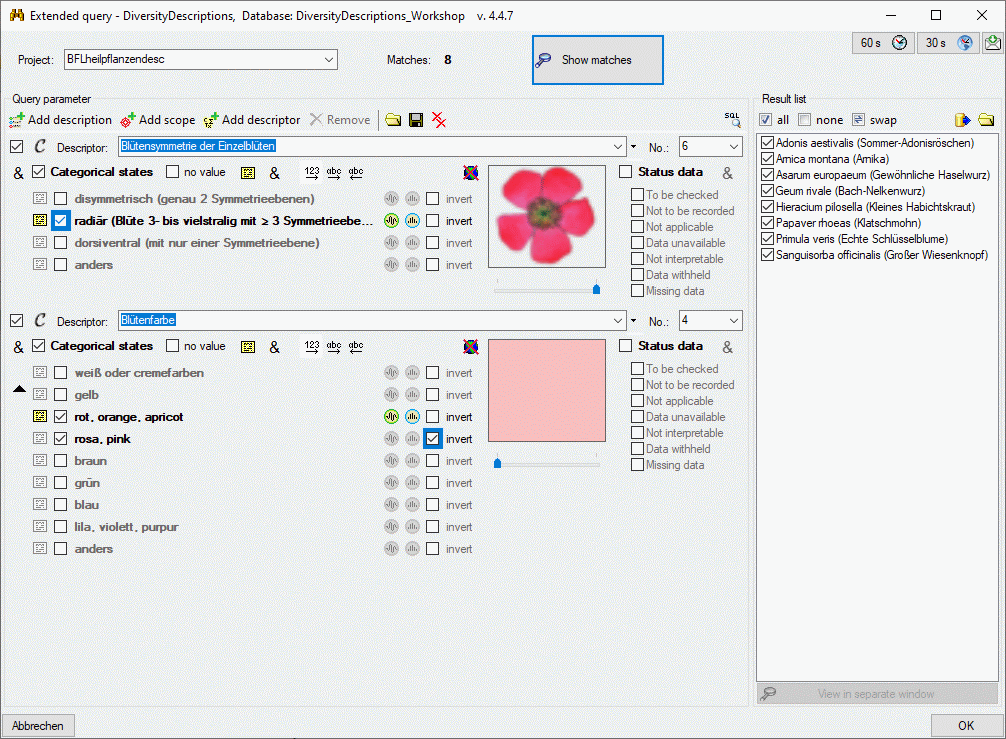
By default all categorical states of a descriptor that are selected must
be present in the matching descriptions. You may change this logical AND
to a logical OR by clicking on the symbol behind the no value check box, which will
change to symbol  (see picture below). Now all descriptions will match, which include one
of the selected states.
(see picture below). Now all descriptions will match, which include one
of the selected states.
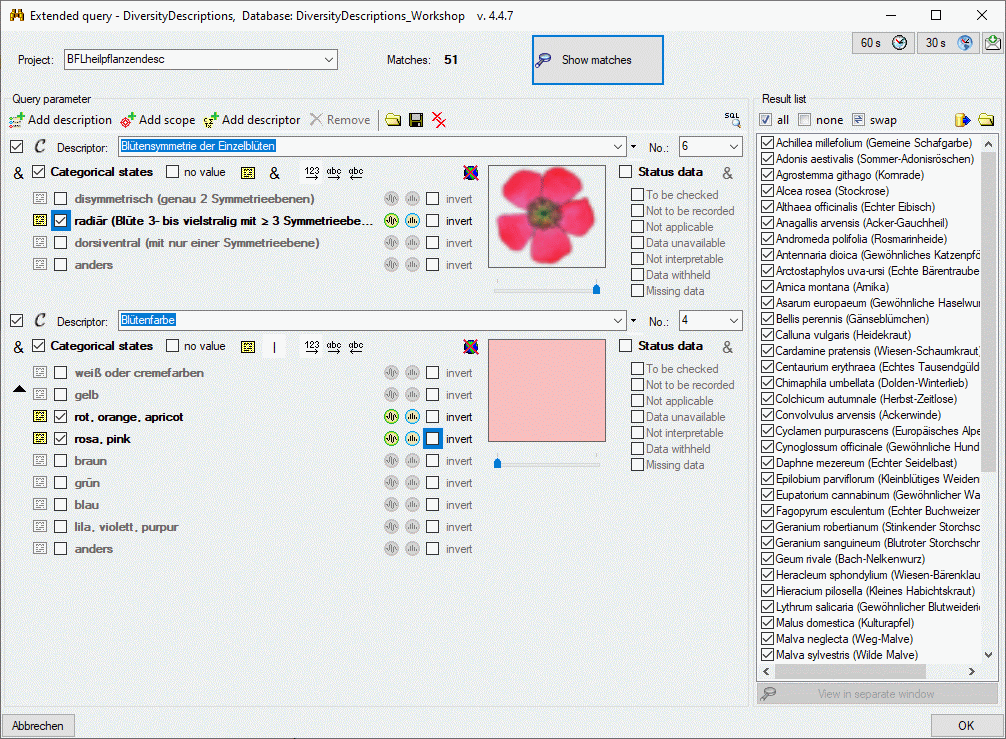
Continue with:
Extended Query
Descriptive text
In this query control you may enter a Search text that shall be part
of the text descriptor data. Capitalization is not taken into account.
For option Contains the descriptor text must contain the search
string (see image below). The options Starts with and Ends with
only check the descriptor text begin rsp. end for a match. Finally
option Exact match requires identical texts. You may use the
wildcards _, [] and [^] in
your search text, but not %. % is automatically inserted in the correct places
by selecting the matching option.
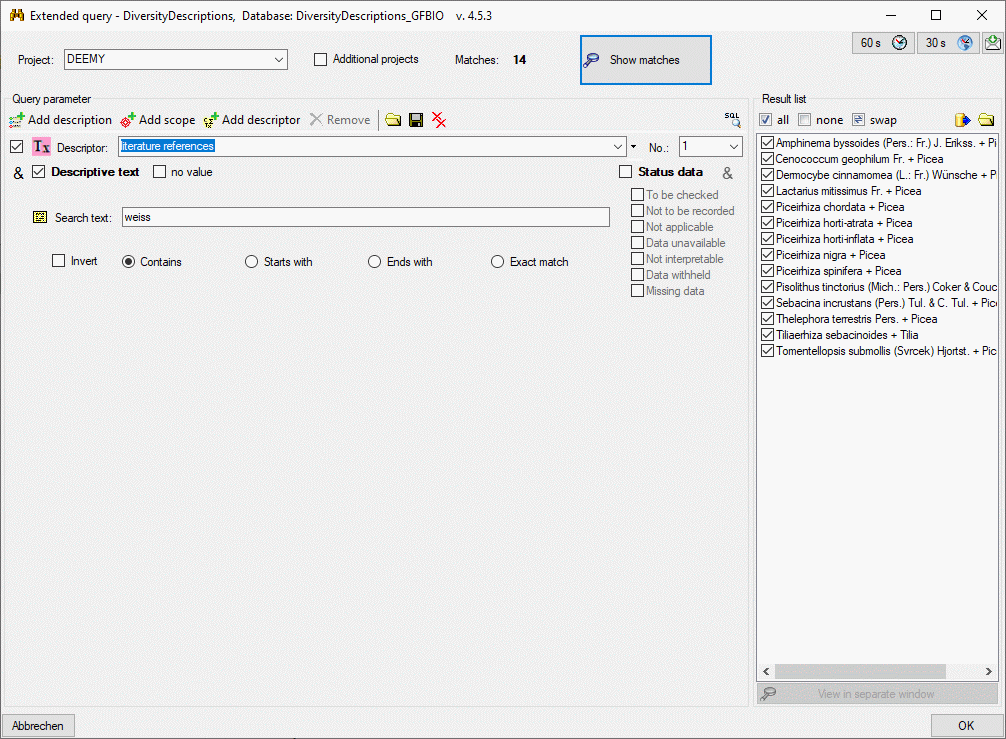
Check the option Invert to invert the search criteria (see picture
below), i.e. there is a match if the descriptive text does NOT contain,
start or end with the specified Search text. The query condition
Invert with Exact match and empty Search text is the query
for descriptive text present. A descriptive text can only be absent if
notes are present, because otherwise the descriptor had no value. You
may search for descriptions that do not have specified any descriptor
data by checking option no value.
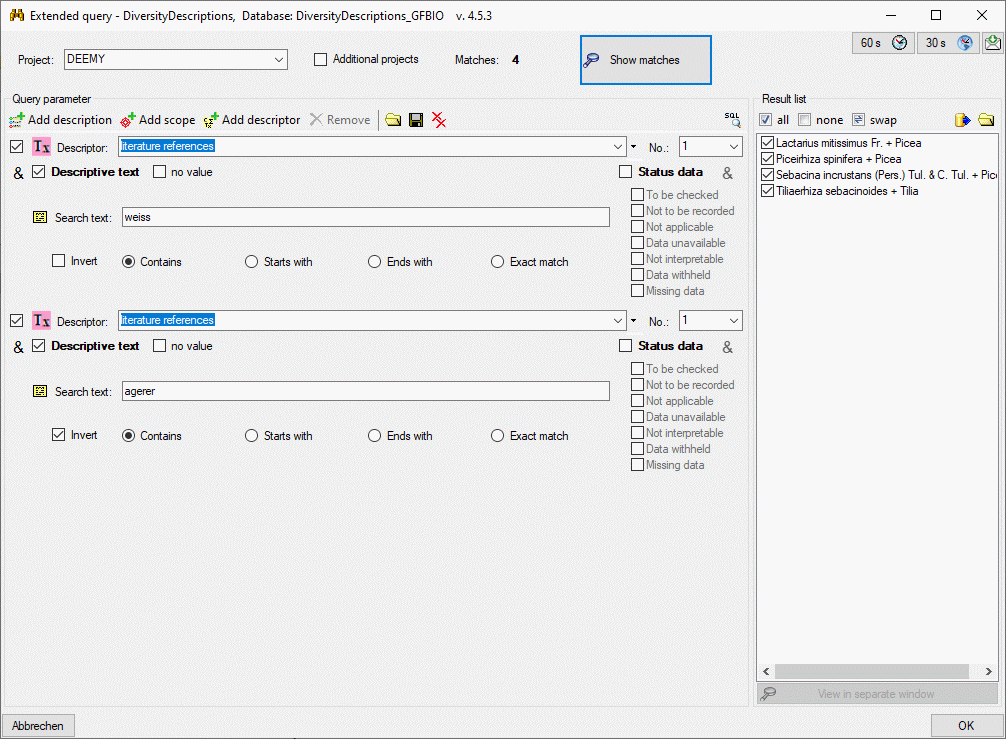
Continue with:
Extended Query
Molecular sequence
In this query control you may enter a Sequence that shall be part of
the molecular sequence data. Capitalization is not taken into account.
For option Contains the sequence text must contain the search string
(see image below). The options Starts with and Ends with only
check the descriptor text begin rsp. end for a match. Finally option
Exact match requires identical texts. You may use the
wildcards _, [] and [^] in
your sequence text, but not %. % is automatically inserted in the correct places
by selecting the matching option.
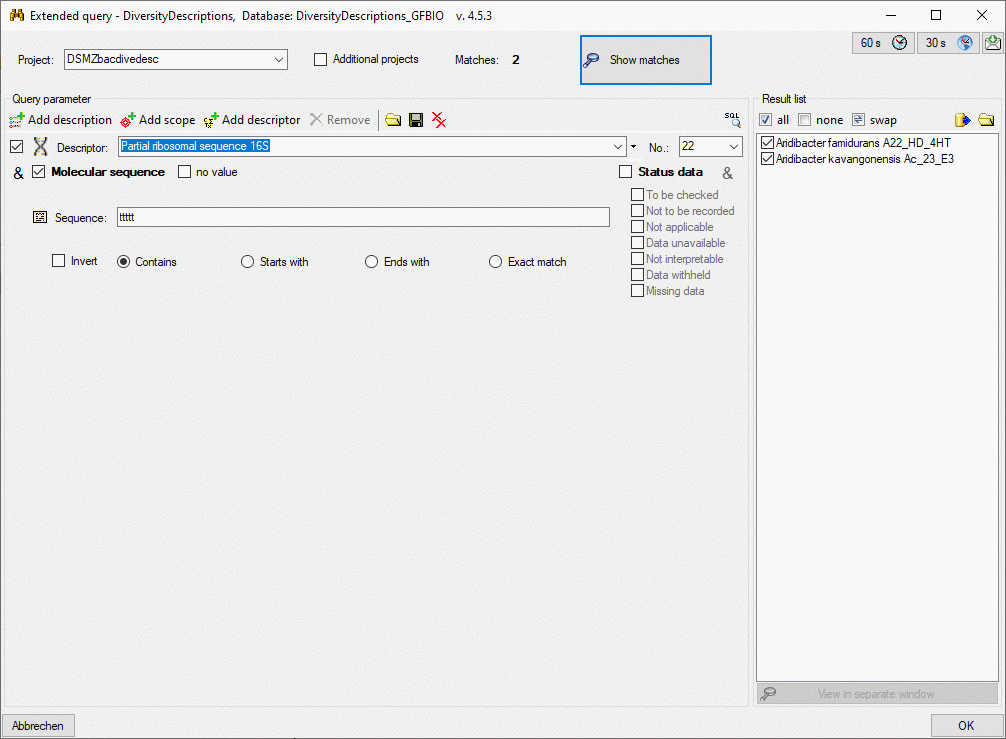
Check the option Invert to invert the search criteria (see picture
below), i.e. there is a match if the molecular sequence does NOT
contain, start or end with the specified Sequence. The query
condition Invert with Exact match and empty Sequence is the
query for molecular sequence present. A molecual sequence can only be
absent if notes are present, because otherwise the descriptor had no
value. You may search for descriptions that do not have specified any
descriptor data by checking option no value.

Continue with:
Extended Query
Statistical measures
In this query control the recommended statistical measures are listed.
You may enter a single value for an exact match in the from: field
or a value range in from: and to: (see picture below). If you
enter no numeric values (or only a value in to:), a search for value
presence will be performed. Remark: If you modify a value in a from:
or to: field, you must leave the field to update the Matches:
count. If you want to exclude the specified value range from the query,
check the invert option. If you do not enter a value, the
statistical measure is checked for presence.
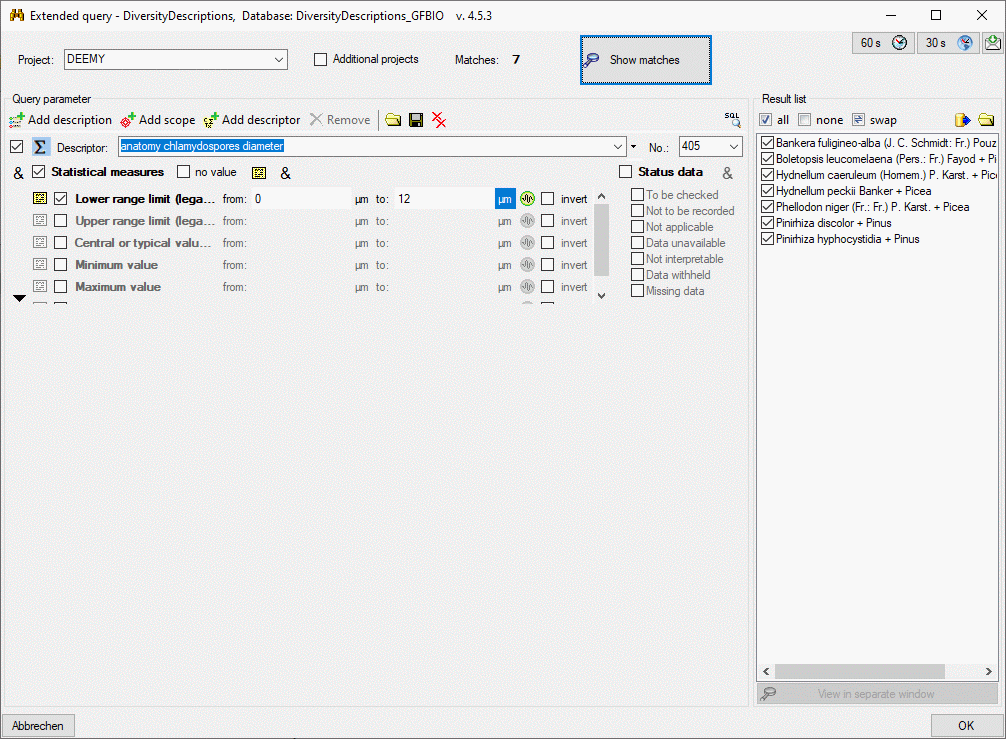
If the statistical measure list exceeds the standard height of the
control, a scroll bar will show at the right side of the statistical
measure list. You can enlarge the control by clicking the button
 at the lower left side (see picture above). To
return to the standard size, click on button
at the lower left side (see picture above). To
return to the standard size, click on button  (see picture below).
(see picture below).
Statistical measures that are not checked are not relevant for the
filter. If you want to search for a statistical measure that is NOT
present, check the option invert and do not enter any values (see
picture below). You may search for descriptions that do not have
specified any statsistical measure by checking option no value.

By default all statistical measure conditions of a descriptor that are
selected must be fulfilled in the matching descriptions. You may change
this logical AND to a logical OR by clicking on the symbol
behind the no value
check box, which will change to symbol
(see picture
below). Now all descriptions will match, which include one of the
selected measure conditions.

Continue with:
Extended Query
Scope conditions
Press button  Add scope in the Query
parameter tool strip to insert a new query parameter condition to
search for specific description scope data. A control representing a
single description scope filter will be added at the end of the query
parameter list. Now you have to select the Scope type that shall be
included in the search filter. You have the choice between the general
scope types (
Add scope in the Query
parameter tool strip to insert a new query parameter condition to
search for specific description scope data. A control representing a
single description scope filter will be added at the end of the query
parameter list. Now you have to select the Scope type that shall be
included in the search filter. You have the choice between the general
scope types ( Geographic area,
Geographic area,
 Sampling plot,
Sampling plot,
 Reference,
Reference,  Observation,
Observation,  Specimen and
Specimen and
 Taxon name) and the project specific
scope types (Other scope, Sex, Stage and Part). The
project specific scope types are only shown if values have been entered
in the database (see Editing the project).
Taxon name) and the project specific
scope types (Other scope, Sex, Stage and Part). The
project specific scope types are only shown if values have been entered
in the database (see Editing the project).
General scopes
After selecting the scope type a query control as shown in the image
below is available. You may search for descriptions that do not have any
scope of the selected type by checking option no value. Otherwise
the two text search fields Scope text and Scope URI are
available, which can be activated by checking the box before the text.
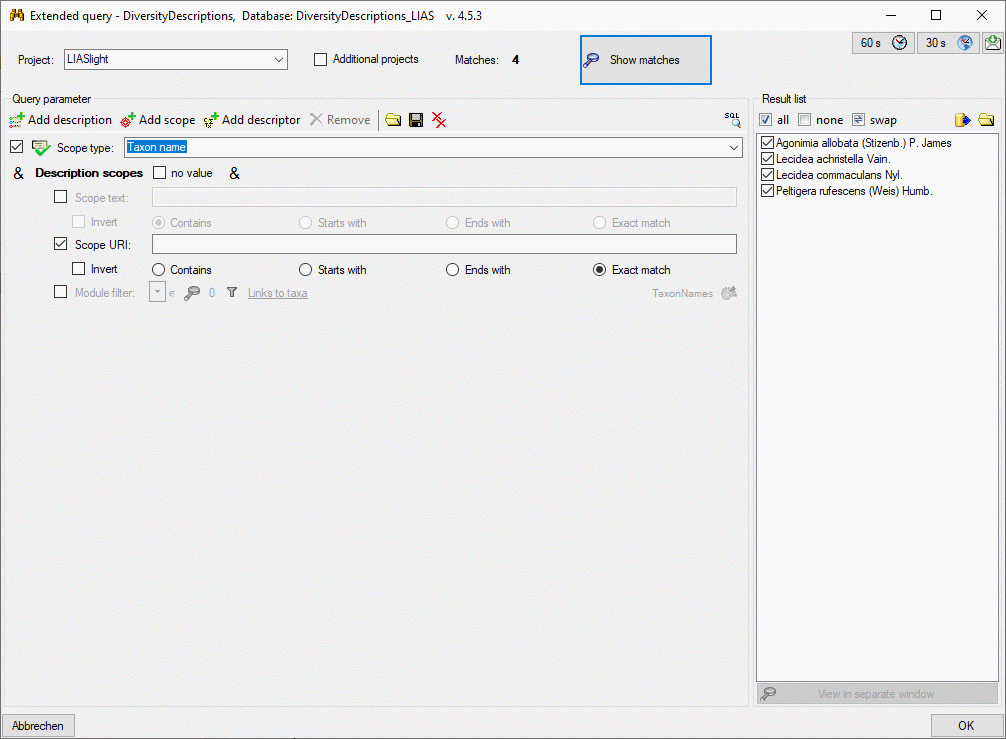
You may enter a search text and select one the matching options
Contains, Starts with, Ends with or Exact match.
Capitalization is not taken into account. For option Contains the
database text must contain the search text. The options Starts with
and Ends with only check the database text begin rsp. end for a
match. Finally option Exact match requires identical texts. For
option Exact match you may enter an empty text, which will match if
in the database an empty text or a NULL value (if a NULL value is
allowed) is present. For the other matching options an empty search text
does not make sense because it will allways match. By checking the
Invert option you may invert the search criteria. E.g. the option
Exact match with empty search text and Invert will search for
“text present” (“not empty string”).
With the query option Module filter you may build a item list from a
linked database using a remore query. You may
search for scopes that match one of the entries (operator ∈) or do not link any of the entries (operator
∉). You may select the operator by clicking
the drop down button . To build the list click
on the  DWB button to open a window where
you can search for values within the linked module. A click on the
DWB button to open a window where
you can search for values within the linked module. A click on the
 button will show a list of the selected items,
button
button will show a list of the selected items,
button  the related database (see image below).
the related database (see image below).
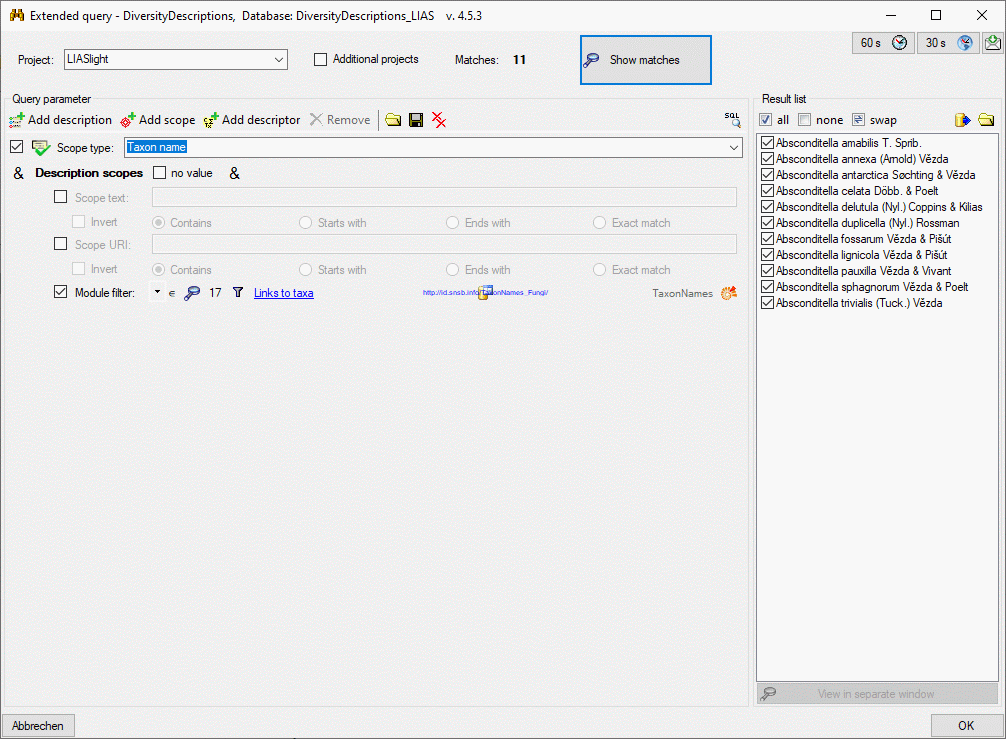
A click on the  filter button switches the filter mode
between link search and text search. For
some scope types, e.g. Taxon names, additional operations are available
(see image below). While for the standard operations all elements of the
query result are entered into the item list, they will take the selected
value as starting value and add synonym/hierarchy values.
filter button switches the filter mode
between link search and text search. For
some scope types, e.g. Taxon names, additional operations are available
(see image below). While for the standard operations all elements of the
query result are entered into the item list, they will take the selected
value as starting value and add synonym/hierarchy values.
| Operator |
Meaning |
Example |
| ∈ |
Search for entries with a list |
Rosa | Rosa caninia \ |
| ∉ |
Search for entries not within a list |
Rosa | Rosa caninia | ... |
+H |
search for entry including lower ierarchy |
Picea | Picea abies | ... |
+S  |
search for entry including synonyms |
Picea abies | Pinus abies | ... |
+HS |
search for entry including lower hierarchy and synonyms |
Picea | Picea abies | Pinus abies | ... |
 |
Change filter mode between link and text |
http://tnt.diversityworkbench.de/TaxonNames_Plants/4269 <> Picea abies L. |
If you entered more than one condition, the default adjustment is that
all conditions must match. This is indicated by the symbol
behind the text Description scopes and the no
value check box, which means “logical AND”. If you want to get a match
for any of the entered conditions, you may click on the symbol
to change it to
“logical OR”.
Project scopes
After selecting a project specific scope all available values inserted
in the database will be listed (see image below). You may select one ore
more of the avalable values. Furthermore you may check the invert option
to search for description entries that do not include the specified
scope value.
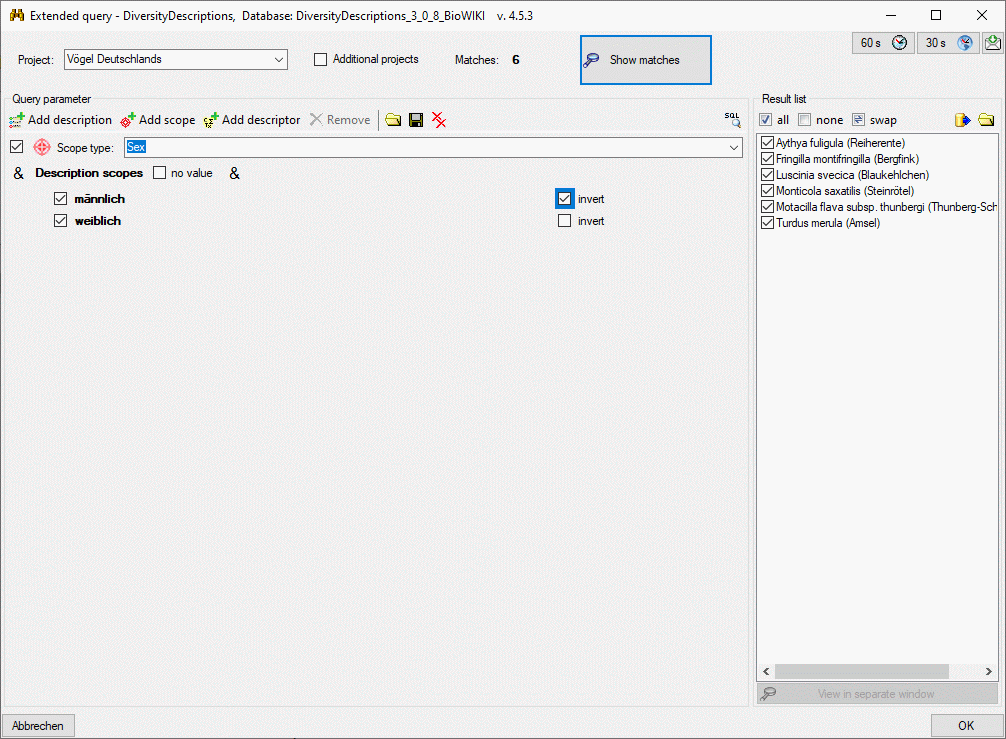
If you entered more than one condition, the default adjustment is that
all conditions must match. This is indicated by the symbol
behind the text Description scopes and the no
value check box, which means “logical AND”. If you want to get a match
for any of the entered conditions, you may click on the symbol
to change it to
“logical OR” (see
image below).
The project specific scope values must be marked as “recommended” for
each project. In the query control you will be shown every value, but
the not recommended ones will be listed with an appropriate text shown
in the image below.
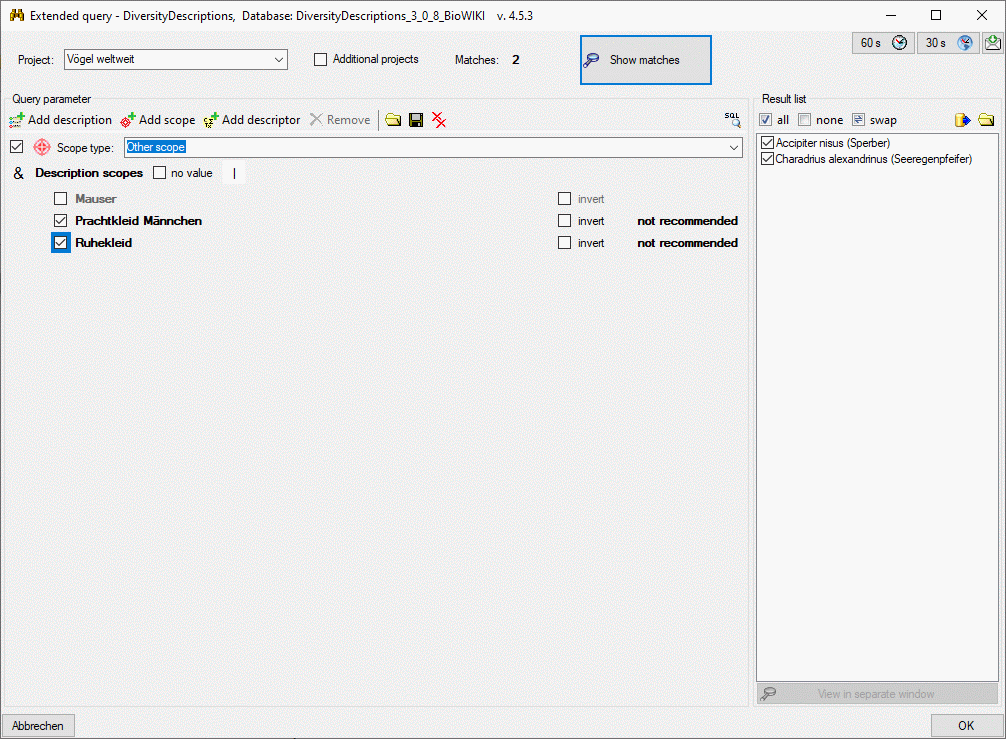
Continue with:
Extended Query
Save and load
The complete query schema may be saved into an XML file using the button
 , which opens a dialog window to enter the file name
and location. By default the schema file name is generated as:
, which opens a dialog window to enter the file name
and location. By default the schema file name is generated as:
<working directory>\ExtendedQuery\DescriptionQuery_<Databasename>_<Project>.xml
The XML schema file includes information concerning the database, the
project and the query parameter. By pressing the  button in the Query parameter section, a query schema file can be
opened. If the schema does not meet the active database you will be
informed by a message box. In the query file all relevant parameter are
identified by the database internal numeric IDs. If no matching values
are found, it is tried to get them by their names. Since the names might
be ambigious, the corresponding element are displayed with a yellow background colour (see image below).
button in the Query parameter section, a query schema file can be
opened. If the schema does not meet the active database you will be
informed by a message box. In the query file all relevant parameter are
identified by the database internal numeric IDs. If no matching values
are found, it is tried to get them by their names. Since the names might
be ambigious, the corresponding element are displayed with a yellow background colour (see image below).
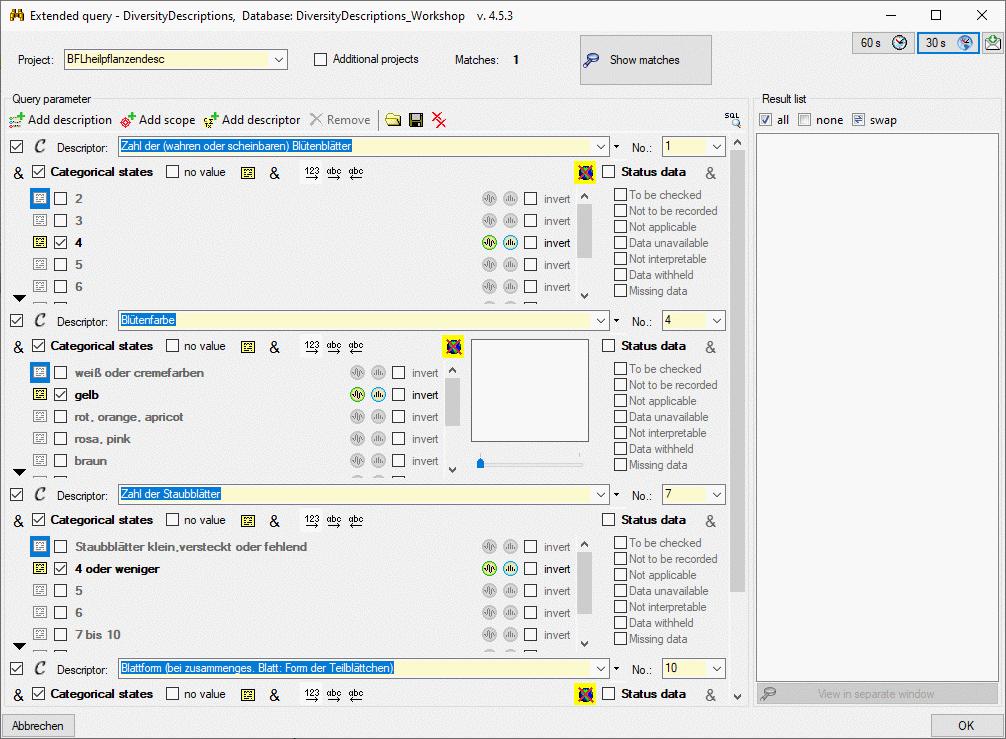
If the parameter could not even be assigned by their names, this is
indicated by a red background color (see
picture below).
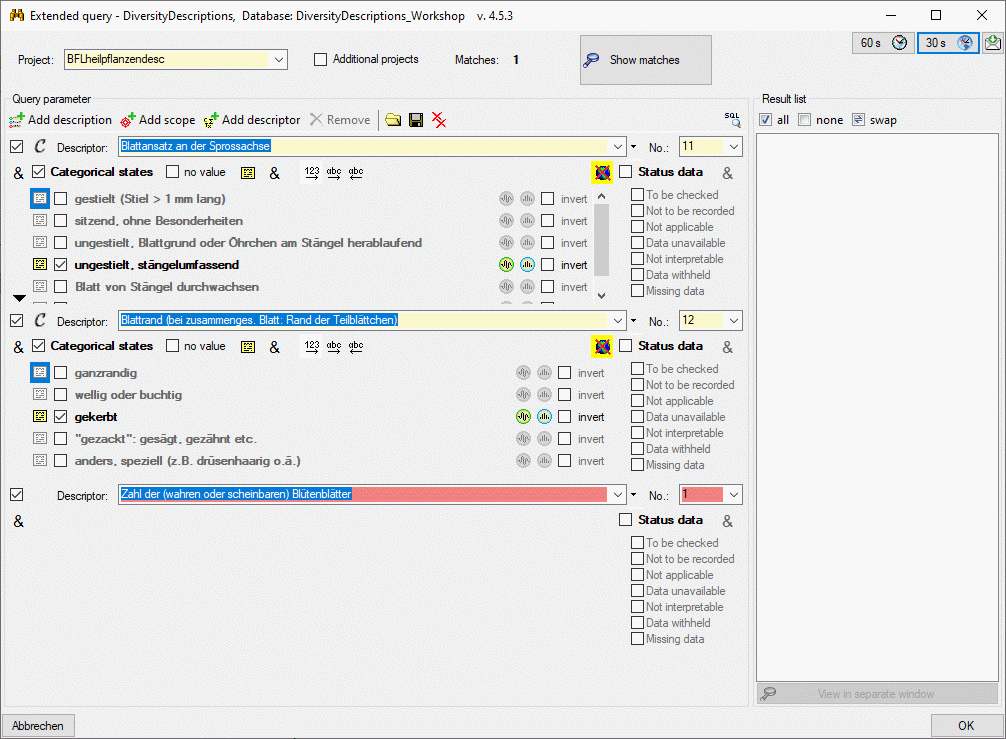


 you can set the timeout for the web access to
resource data. Feedbacks can be sent with the button
you can set the timeout for the web access to
resource data. Feedbacks can be sent with the button



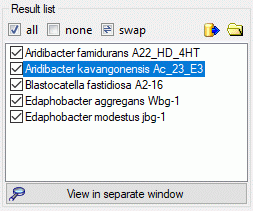






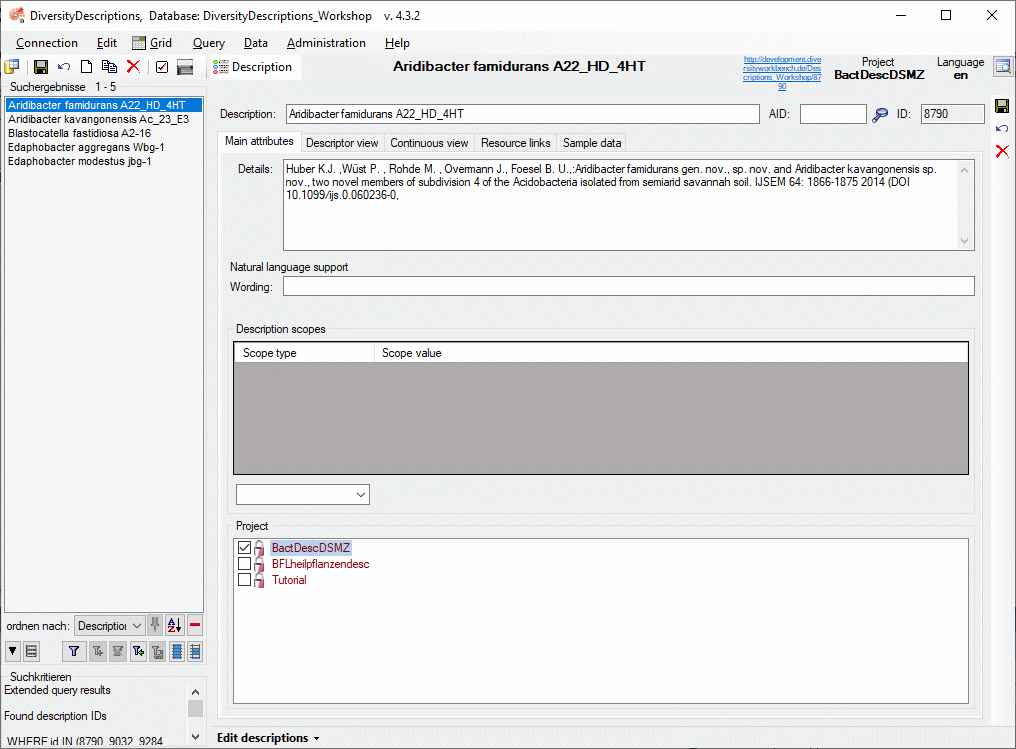

 Add description,
Add description,
 Add scope or
Add scope or
 Add descriptor in the Query
parameter tool strip a query parameter control is inserted at the end
of the query parameter list. When you enter query parameter, the field
Matches: will be updated immediatly. To see the Result list, you
will have to click on button
Add descriptor in the Query
parameter tool strip a query parameter control is inserted at the end
of the query parameter list. When you enter query parameter, the field
Matches: will be updated immediatly. To see the Result list, you
will have to click on button 

 . You can delete the
current query control by clicking on button
. You can delete the
current query control by clicking on button  Remove or all query controls by clicking on button
Remove or all query controls by clicking on button
 in the Query parameter tool strip.
in the Query parameter tool strip.






 categorical,
categorical,
 quantitive,
quantitive,  text or
text or
 sequence). If additional information for the
descriptor are available in the database, you can show them as bubble
help by moving the mouse cursor over the symbol. If resource data are
available for a descriptor, the symbol is displayed with coloured
background and you can view them by double-clicking it (see image
below).
sequence). If additional information for the
descriptor are available in the database, you can show them as bubble
help by moving the mouse cursor over the symbol. If resource data are
available for a descriptor, the symbol is displayed with coloured
background and you can view them by double-clicking it (see image
below).
 (logical OR) to
find matches for any of the selected status data values.
(logical OR) to
find matches for any of the selected status data values.  is included at the appropriate places. To
enter a query condition, click the button and a window as shown below
will be opened.
is included at the appropriate places. To
enter a query condition, click the button and a window as shown below
will be opened.
 ). If you want to
remove the query condition, open the notes form, uncheck the Enable
notes filter option and click OK.
). If you want to
remove the query condition, open the notes form, uncheck the Enable
notes filter option and click OK.
 (modifier) and
(modifier) and  (frequency) are included at the
appropriate places. To enter a query condition, click the button and a
window as shown below will be opened.
(frequency) are included at the
appropriate places. To enter a query condition, click the button and a
window as shown below will be opened.

 ,
,
 ). If you want to remove the query
condition, open the form, uncheck the Enable filter option and click
OK.
). If you want to remove the query
condition, open the form, uncheck the Enable filter option and click
OK.

 and reverse alphabetical
order
and reverse alphabetical
order  by clicking the appropriate button. If
the state list exceeds the standard height of the control, a scroll bar
will show at the right side of the state list. You can enlarge the
control by clicking the button
by clicking the appropriate button. If
the state list exceeds the standard height of the control, a scroll bar
will show at the right side of the state list. You can enlarge the
control by clicking the button  at the lower
left side (see picture above). To return to the standard size, click on
button
at the lower
left side (see picture above). To return to the standard size, click on
button  (see picture below).
(see picture below).












 Geographic area,
Geographic area,
 Sampling plot,
Sampling plot,
 Reference,
Reference,  Observation,
Observation,  Specimen and
Specimen and
 Taxon name) and the project specific
scope types (Other scope, Sex, Stage and Part). The
project specific scope types are only shown if values have been entered
in the database (see
Taxon name) and the project specific
scope types (Other scope, Sex, Stage and Part). The
project specific scope types are only shown if values have been entered
in the database (see 
 DWB button to open a window where
you can search for values within the linked module. A click on the
DWB button to open a window where
you can search for values within the linked module. A click on the
 the related database (see image below).
the related database (see image below).
 filter button switches the filter mode
between
filter button switches the filter mode
between 






